Gold Holds Steady Above $3,100 as Market Turmoil Deepens, But Bulls Show Signs of Fatigue.
Gold (XAUUSD), true to its historical role, has stood firm above the $3,100 mark, even as broader markets continue to bleed. However, despite its resilience, the precious metal is showing signs of hesitation, as bulls appear reluctant to commit fully to fresh positions. The global financial landscape is undergoing a period of extreme turbulence, with investors rushing to safe-haven assets amid fears of an imminent recession.
Following a dip to a near four-week low around $2,972 during early Monday trading in Asia, gold prices rebounded modestly. The recovery, however, stalled near the $3,055 level—a price zone that now acts as a resistance after previously serving as support. This technical flip, combined with broader investor behavior, highlights a growing cautiousness that permeates the gold market.
Global Panic and the Return to Safety
The backdrop to gold’s recent movements is nothing short of chaotic. Markets around the world are grappling with the ripple effects of heightened trade tensions, slowing economic growth, and uncertain central bank policies. The most notable flashpoint has been the re-emergence of a US-China trade war.
Late last week, US President Donald Trump introduced a sweeping package of reciprocal tariffs, affecting nearly all imported goods. China, in turn, retaliated with its own series of levies. With China now facing a staggering 54% tariff burden under the new regime and the US doubling down with no indication of backing off, global supply chains are bracing for another shock. This geopolitical chess match has led investors to flee riskier assets and seek refuge in safer instruments like gold.
Yet, despite this apparent risk-off sentiment, gold’s rally has not been as aggressive as one might expect. Instead, its recent bounce seems limited and lacks strong follow-through. This is largely because investors are not just fleeing to safety—they are also liquidating assets across the board to raise cash, cover margin calls, or reposition themselves entirely in light of new global realities.
People’s Bank of China Expands Gold Reserves.
Adding further intrigue to the gold narrative is the continued accumulation of gold by central banks—particularly the People’s Bank of China (PBOC). Data released earlier today confirms that China has added to its gold reserves for the fifth consecutive month. The central bank reportedly increased its holdings by 0.09 million troy ounces in March alone.
This quiet but consistent buildup in gold reserves reflects China’s long-term strategy to diversify away from the US dollar and secure more stable, tangible assets amid intensifying geopolitical tensions. For market participants, the PBOC’s actions offer a degree of confidence in gold’s strategic value, even if near-term price movements remain choppy.
Fed Rate Cut Bets Weigh on the US Dollar
Another major support for gold prices is the weakening US Dollar (USD). While the dollar attempted a mild rebound last Friday on the back of a stronger-than-expected Nonfarm Payrolls (NFP) report—which showed the US added 228,000 jobs in March—it has since struggled to hold onto gains. The NFP report beat expectations, but it was not enough to sway growing market sentiment that the US economy is heading for a slowdown.
In fact, many investors are now betting that the Federal Reserve will resume its rate-cutting cycle as early as June. Traders are currently pricing in as many as four rate cuts this year, driven by fears that the Trump tariffs could trigger a broader economic slowdown and fan inflationary pressures.
Fed Chair Jerome Powell, speaking last week, acknowledged that inflation remains slightly elevated but “closer to target.” He also warned that tariffs could have a strong inflationary impact if sustained, stating that the Fed must act to ensure temporary price surges do not become entrenched. This dovish tone, combined with rate cut expectations, has capped any meaningful recovery in the USD—and in turn, provided a soft tailwind for gold.
Yield Pressure Supports Non-Yielding Gold
The yield on the benchmark 10-year US Treasury note continues to hover below the critical 4.0% level, further supporting gold’s relative appeal. As bond yields drop, the opportunity cost of holding non-yielding assets like gold diminishes, making them more attractive. This dynamic is a fundamental driver behind gold’s persistent appeal in a low-rate or rate-cutting environment.
However, while macroeconomic factors are generally supportive of gold, the price action tells a more nuanced story. Bulls are not chasing the rally with confidence. Instead, there’s an air of hesitation—perhaps stemming from fears of a deeper market correction or simply exhaustion after gold’s strong run in previous months.
Traders Caught Between Fear and Foresight
The current gold market is caught in a paradox. On one hand, the macroeconomic and geopolitical environment strongly favors gold as a hedge against volatility. On the other, traders are operating in a highly unpredictable landscape, making them wary of overcommitting in any single direction.
This is evident in the way price movements are unfolding. Each attempt at a breakout above resistance levels is met with selling pressure, suggesting that investors are either locking in profits or reducing risk. Meanwhile, pullbacks toward the $2,970-$2,980 range attract buying interest, as investors step in to defend perceived value zones.
Looking Ahead: Can Gold Sustain Its Momentum?
The big question now is whether gold can maintain its position above $3,100 in the coming weeks, especially with several key events on the horizon. These include:
The next round of inflation and GDP data from the US.
Fed policymakers’ comments and possible signals regarding the June meeting.
Any further escalation—or de-escalation—of the US-China tariff conflict.
Central bank buying activity, particularly from emerging markets.
While the fundamentals remain broadly supportive, it’s clear that gold’s rally may require stronger conviction from bulls if it’s to test new highs beyond the recent record levels.
Conclusion
Gold’s ability to hold above $3,100 in the face of a global market meltdown underscores its enduring role as a store of value. Yet, the current lack of aggressive bullish participation signals caution among traders, who are torn between gold’s long-term appeal and the short-term need for liquidity and safety.
With global risks on the rise and monetary policy in flux, gold is likely to remain a focal point for investors in the weeks ahead. Whether it breaks decisively higher or continues to tread water will depend on how deeply economic conditions deteriorate—and how the world’s major central banks respond.









